Trade lights in Beijing, with legends as China’s capital, house the integration of innovation, history, traditions, and culture. In 4-days, experience historical landmarks, savor different cuisines, and discover untold wonder through this guide. This itinerary pairs relaxing and exploring perfectly, making it favorable for experts and beginners. Visit the Great Wall, Olympic Park, Hutongs, and the magnificent Forbidden City. Rid yourself of misconceptions as you experience the blend of ancient and modern marvels that is China. This guide prepares you to indulge in the secrets of China’s architectural beauties and their rich flavors. Soak in the abundant energy and have fun while exploring this diligently crafted guide.
What to Expect on Day 1 of Your Beijing Itinerary?
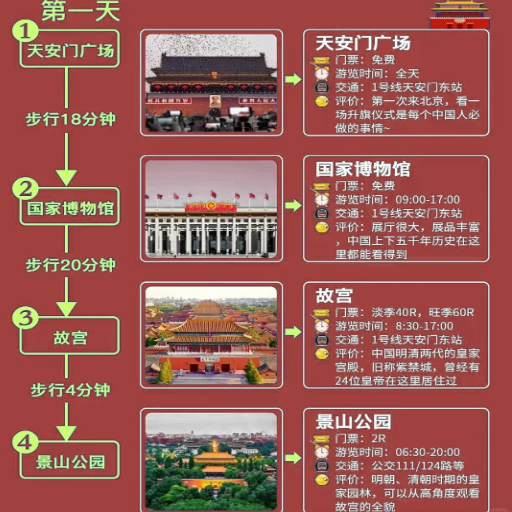
What to Expect on Day 1 of Your Beijing Itinerary
Kickoff day one in Beijing will include a visit to Tiananmen Square, one of China’s historical landmarks. This is followed by exploring the Forbidden City, a UNESCO World Heritage Site and a masterpiece of architectural prowess. Once finished, walk around Jingshan Park to enjoy a relaxing city view. At the end of the day, rejuvenate with traditional food from Beijing.
Exploring Tiananmen Square and Its Rich History
The famous public square of Tiananmen stretches across 440,500 square meters, making it one of the largest. Initially, it was built in 1651 but was operationalized in 1950. At that point, it had many iconic locations being set up around it, such as the Great Hall of the People, the National Museum of China, and the Mausoleum of Mao Zedong.
The Square represents China’s political change over time and hosts significant historical events. People can observe the flag-raising ceremony at sunrise, an impressive military march organized by the People’s Liberation Army. For planning purposes, note the flag’s central Geo coordinates (39°54’12”N 116°23’30”E), allowing the flag to issue identification for some bordering structures. The best visit times are early mornings or late afternoons, with stomachs for when the crowds are small.
Discovering the Forbidden City: A UNESCO World Heritage Site
Located in the heart of Beijing, China, the Forbidden City, at 39°54′56″N 116°23′28″E, is an epic architectural wonder and represents imperial China. Built between 1406 and 1420 during the Ming dynasty, it served as an imperial palace to 24 emperors until the fall of the casual System attempted by the Qing dynasty in 1972. The massive complex covers over 180 acres and has around 980 surviving buildings and 8700+ rooms, making it the most extensive collection of wooden structures worldwide.
Key Features and Highlights
- Gate of Supreme Harmony (Taihemen): This is the primary ceremonial gateway leading to the gigantic Hall of Supreme Harmony. It features a set of columns with ornate carvings.
- The Meridian Gate (Wumen) – Serves as the southern entrance where guests get their first impression of the magnificence within the palace walls.
- The Palace Museum Houses hundreds of thousands of cultural relics, including paintings, pottery, sculptures, and ancient books.
Tips for Visiting
- Operating Hours:
- From April to October: 8:30 AM–5:00 PM (last entry at 4:00 PM).
- From November to March: 8:30 AM–4:30 PM (last entry at 3:30 PM).
- Closed on Mondays (except national holidays and special occasions).
- Ticket Prices:
- April to October: 60 RMB.
- November to March: 40 RMB.
- Special exhibitions may require an additional fee.
- Advance Booking:
- Ticket purchasers who can purchase tickets online up to 10 days in advance must show a government-issued ID or passport.
- Accessibility:
- The area is wheelchair accessible mainly at some locations, which have been provided with ramps at essential places.
- Recommended Timing:
- Holidays during the early and late hours of the day, for instance, the morning and the afternoon when there are no tourists, are favorable.
- Make sure to comprehensively cover the main attractions at least 3-4 hours.
The Forbidden City encompasses over 600 years of history, culture, and art and offers insight into the grandeur and sophistication of China’s imperial heritage. Its unique combination of magnificent beauty and complex history makes it a treasured site worldwide.
Strolling Through Jingshan Park for Stunning Views
Jingshan Park has some of the most spectacular views of Beijing from the central hill, the city’s highest point. On my visit, I climbed up to Wanchun Pavilion at the summit and was left speechless by the magnificent views of the Forbidden City. Going sightseeing is best done in the early morning and late afternoon when the light illuminates the palaces’ golden roofs. The park welcomes visitors daily, and the entrance fee is usually between 2-10 RMB, depending on the season. The well-kept pathways are moderate and steep, so most visitors should be comfortable walking through. Photographers will have a field day capturing great shots of the Forbidden City from the summit, so I recommend bringing a telephoto lens.
How to Spend Day 2 in Beijing: Must-See Attractions
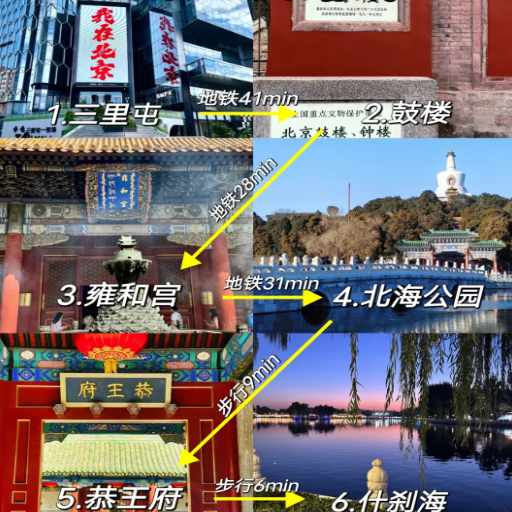
How to Spend Day 2 in Beijing: Must-See Attractions
Morning: Temple of Heaven
Begin your day by exploring the Temple of Heaven, one of the ancient sites that UNESCO protects. This complex was where the emperors made sacred prayers for a good harvest. Walk through the beautiful park in the adjacent area, boasting locals practicing tai chi, playing musical instruments, or flying kites. The site opens early, so arriving before 9 AM will help you bask in the shroud of peace around the location before it gets overcrowded.
Afternoon: Summer Palace
Afterward, head to the Summer Palace, a splendid example of traditional Chinese landscaping. The palace is famous for the serene Kunming Lake and Longevity Hill. Pack a light snack with you or buy lunch from one of the nearby restaurants before heading to the garden. A relaxing boat ride across the lake is a fantastic way to cool off and enjoy the surroundings.
Evening: Wangfujing Street
Beijing boasts an exquisite shopping and food district, which makes for a splendid evening stroll. Visit Wangfujing Street before calling it a day. The street offers ample shopping opportunities and several food joints serving local delicacies. For more adventurous ones, the night market comes alive with odd yet interesting snacks ranging from candied fruits to deep-fried scorpions. You can never know until you try. It’s the right way to conclude your second day in Beijing while you soak in the city’s vibrant culture.
These attractions combine history, beauty, and cultural immersion, making them must-see spots for everyone traveling to Beijing.
Visiting the Majestic Temple of Heaven
The Temple of Heaven in Beijing is an architectural marvel and a UNESCO World Heritage Site. The Temple showcases the spirituality and ingenuity of ancient China. This complex was a ceremonial site where emperors of the Ming and Qing dynasties worshiped and prayed for stupendous harvests. The Round Altar, Imperial Vault of Heaven, and the Hall of Prayer for Good Harvests are the best examples of symbolic structures of design, every detail reflecting ancient Chinese cosmology.
Key Aspects and Highlights
- Construction Period: The temple was built in 1420 during the Ming Dynasty and changed in the 16th and 18th centuries.
- Materials Used: Wood and marble were primarily used for its construction, symbolizing harmony between heaven and earth.
- Architectural Features:
- The Hall of Prayer for Good Harvests is a wooden structure with a triple-gabled circular design famous for being constructed without nails.
- The Circular Mound Altar has three levels made out of marble, which signifies heaven, earth, and mankind.
- An Echo Wall uniquely transmits sound over a distance, a feature of the Imperial Vault of Heaven.
- Cosmological Significance:
- The buildings and directions in which they face adhere to Chinese Feng Shui.
- The northern section is an incomplete circle (which symbolizes the heavens), while the southern part is a square (which represents the earth).
The Temple of Heaven is not only breathtaking due to its historical significance, but its serene surroundings, intricate design, and history truly make it a splendid view as one of the most awe-inspiring landmarks. When visiting the Taj Mahal, explore the surrounding park where the locals spend their leisure time practicing Tai Chi and other traditional dances and music – truly phenomenal to behold.
Exploring the Bustling Hutongs of Old Beijing
The uniquely structured and culturally rich Beijing hutongs are characterized by their historically significant narrow alleyways. These neighborhoods date back to the Yuan Dynasty, suggesting that they are integral to Beijing’s social and historical city planning. Several generations of families are believed to have lived together in the now traditional courtyard homes known as siheyuan, which frame numerous hutongs.
While visiting hutongs like Yandaixiejie or Nanluoguxiang, tourists can enjoy the many cafes, small shops, and street food vendors that give these alleys their lively character. Cultural sites like the Bell and Drum Towers and insightful rickshaw tours of the area that narrate its rich history are also popular among outsiders.
With the growing pace of modern urbanization, these areas are in danger of disappearing, but steps have been taken to ensure the preservation of specific culturally significant sites. Some remain well known for striking a balance between modern and traditional appeal, making them increasingly popular with tourists seeking to experience Beijing’s charm.
Evening at the Summer Palace: Imperial Gardens and Lakes
Evening visits to the Summer Palace were magical moments, like something out of a fairy tale. The sunset glowing in warm tones of light brought life into the expansive and imperial gardens enhanced with extravagant pavilions and calm walk paths. The warm water at Kunming Lake matched the soft hues of golden light while I strolled around the edges, filling me with a deep sense of tranquility. As expected, Longevity Hill is home to breathtaking views. The UNESCO World Heritage Site surprised me time and again. It is regarded as the ‘highest achievement of garden art’ in China, beautifully designed and crafted. The complex merges natural landscapes and constructed buildings, harmonizing nature and architecture through thoughtful planning and skillful craftsmanship.
These incredible features include the lake’s nearly 2.9 square kilometers and the expansive gardens comprising more than three thousand architectural structures like temples, corridors, and bridges. To achieve the iconic aesthetics that the Summer Palace is known for, a balance of open waters and abundant greenery is necessary, in addition to taking care of proportion in history preservation. Incredibly serene and stunning, this location embodies bold changes in nature and rich history.
What Can You Discover on Day 3 of Your 4-Day Beijing Tour?
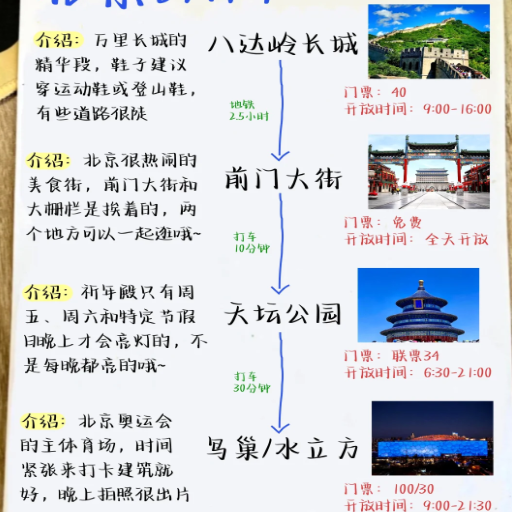
What Can You Discover on Day 3 of Your 4-Day Beijing Tour
During your 4-day Beijing tour, day 3 will allow you to visit the awe-inspiring Forbidden City, a UNESCO World Heritage Site. The Imperial Palace of the Forbidden City served as a palace for 24 Emperors during the Ming and Qing Dynasties. Be sure to appreciate its architecture, cultural relics, and details, which truly portray and exceed 600 years of history. Later, stroll through Jingshan Park, where you can glimpse the palace and the beautiful city. This day enriches your understanding of Beijing’s imperial history and culture.
Adventure to the Mutianyu Section of the Great Wall
The Great Wall Mutuanyu section is famous for its fantastic view, well-maintained structures, and fewer visitors than other sections. This part of the wall, about 2.5km long, was built during the Ming Dynasty and has 22 watchtowers along the section spaced a kilometer apart. Travelers can also admire the wall’s impressive features, like the battlements and crenels, which showcase its importance as a defensive structure.
Key Highlights:
- Length: 2.5 km (1.55 miles)
- Watchtowers: 22 on this stretch
- Materials: Primarily bricks and stone
- Difficulty: Moderate, with restored pathways ideal for walking or hiking
- Transport Options:
- Cable Car: Ideal for saving time and energy, offering scenic rides to Station 14.
- Toboggan Slide: A thrilling and fun descent option.
- Scenic Features: The 96% of the area covered by lush forests surrounding the wall creates a picturesque backdrop in any season.
The area combines natural beauty, modern convenience, and historical context, making it perfect for anyone hoping to have an unforgettable, enriching experience.
Experience the Lama Temple and Its Spiritual Significance
The Lama Temple, or Yonghe Temple, sits in the center of Beijing as an otherworldly piece of religious architecture and history. It was built in 1694 to serve as the home of Prince Yong, who later was the Yongzheng Emperor, but was transformed into a Tibetan Buddhist temple in 1744, which proves its ongoing spiritual significance. The temple was designed and built with blended Han and Tibetan features, making it a culturally rich and visually stunning landmark.
- Key Features:
- The Hall of Harmony and Peace (Yonghegong) houses three bronze Buddha statues representing the past, present, and future.
- The Pavilion of Ten Thousand Happinesses (Wanfuge) holds the record for the largest single wood carving, with its 18-meter-tall Maitreya Buddha statue carved from a single white sandalwood tree.
- The Temple Layout has five main halls and several courtyards, which follow the traditional Chinese symmetrical style.
- Spiritual Practices:
- The temple is a significant site for Tibetan Buddhism, so it is common for worshippers and visitors to light incense and pray in front of the many Buddha statues.
- The temple is surrounded by culture, so monks bless and conduct rituals while people learn and exchange.
- Visitor Information:
- Opening Hours: 9 AM to 4 PM daily (closed on Mondays).
- Admission Fee: 25 RMB for adults, free for children under 1.2 meters tall.
- Transportation:
- Subway: Line 2 or 5 to Yonghegong Lama Temple Station, Exit C.
- Bus: Multiple buses, including lines 116 and 684, stop nearby.
In addition to its peaceful and soul-uplifting surroundings, the Lama Temple provides another exceptional vantage point for synthesizing Chinese and Tibetan cultures. Its history, artistic details, and tranquil environment make it one of the most stunning highlights in Beijing.
Exploring the Historical Qianmen Street
Strolling down the Qianmen shopping district is as fascinating as the city’s history. It is one of the oldest streets in Beijing and offers stunning examples of traditional Chinese style intermixed with modern buildings. To the sides of the street, numerous shops provide everything from local delicacies such as roast ducks to souvenirs. The street also contains some of Beijing’s famous old brands, such as the more than century-old Quanjude Roast Duck Restaurant.
The charm of the vintage Qianmen district still exists, further enhanced by the street tram. The tram is a great way to explore; it costs 20 RMB. It is an excellent value for an authentic experience traveling in the 20th century. Vintage appeal coupled with modern infrastructure gives Qianmen Street endless character.
How to Make the Most of Day 4: Final Day of Your Beijing Itinerary
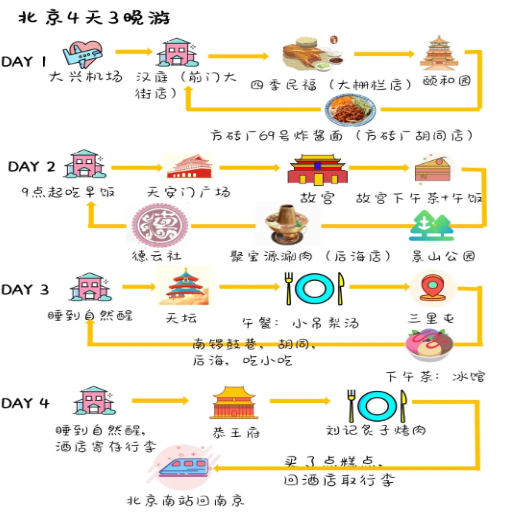
How to Make the Most of Day 4: Final Day of Your Beijing Itinerary
On your last day, aim to start earlier and head to Qianmen Street to take in all its charms before the crowd arrives. Walk around the historic shops and try the local specialties, like roast duck and mouthwatering sesame cakes. A tram ride might also be a great idea to take in the vintage scenery while helping you cover more area. Utilize the time to capture the street’s architectural designs and the zealous vibe of the place. If your schedule allows it, make a note to visit nearby locations such as Tiananmen Square or the Temple of Heaven to experience Beijing fully. Most importantly, set aside a little time to get unique souvenirs to remember the trip before heading to your following location or the airport. Good planning will ensure that your last day in this phenomenal city will go as splendidly as any other day in your itinerary.
Morning Visit to the National Museum of China
Make your way to Tiananmen Square’s eastern side and prepare for a full day of revelatory learning at The National Palace Museum of China. The museum is best known for its extensive collection of exhibits, which exceeds a million pieces and includes everything from age-old antiques to contemporary pieces. It gives the visitors an accurate portrayal of China’s diverse history and culture. Set aside a generous amount of your time, 2-3 hours, when planning for the museum, as they have bronze age treasures, ancient ceramic items, and a myriad of other exhibits to showcase.
Notes for Planning Your Visit:
- Opening Hours: 9:00 AM – 5:00 PM (Closed on Mondays)
- Admission: Free, but tickets must be reserved online in advance with a valid ID or passport.
- Key Highlights:
- Ancient Chinese Bronzes (Hall of Ancient China)
- The Jade Exhibition (features exquisite craftsmanship)
- Art from the Ming and Qing Dynasties
- Visitor Tips:
- Arrive early to avoid crowds.
- Most locations allow photographs to be taken, but taking pictures with a flash is frequently banned.
- Due to the large number of expansive halls, wearing shoes that are easy to walk in is recommended.
This trip will help change your outlook towards China’s history while improving your cultural understanding of Beijing.
Relaxing Afternoon at the Beijing Zoo
The Beijing Zoon is situated in the Xicheng District. It is a great place to spend a peaceful afternoon viewing more than 450 species of animals in beautifully landscaped and serene areas of greenery. It is part of a larger complex covering approximately 89 hectares (220 acres) and has open-air and naturalistic enclosures. It is a monument of education, recreation, and nature, famous for its beautiful gardens and historic buildings.
Highlights of the Beijing Zoo:
- Giant Panda Hall: This must-see exhibit is the most popular in the zoo. Friendly pandas can be seen in large enclosures that replicate their natural environments.
- Aquarium (additional admission fee of around RMB 150): One of the most significant inland aquariums in Asia, featuring marine life, dolphin shows, and various kinds of freshwater animals.
- Rare Animals: Endangered animals on display include South China tigers, golden snub-nosed monkeys, and Pere David’s deer, which visitors can view.
Notes for Visitors:
- Opening Hours:
- April to October: 7:30 AM – 6:00 PM
- November to March: 7:30 AM – 5:00 PM
- Admission Fees:
- Zoo Ticket Only: RMB 15 (Adults), RMB 8 (Children under 1.2 meters)
- Combined Zoo and Aquarium Ticket: RMB 150
- Location:
- Address: 137 Xizhimen Outer Street, Xicheng District, Beijing
- Easily accessible via Beijing Zoo Station (Subway Line 4).
Visitor Tips:
- Arrive early to visit the Giant Panda Hall when it’s less crowded.
- Purchase tickets online to save time.
- Wear comfortable walking shoes, as the sprawling grounds involve a lot of walking.
- Consider visiting during weekdays for a quieter experience.
- Bring water and snacks, as dining inside the zoo is limited.
The Beijing Zoo features splendid gardens and glimpses of its rich history. It also features fascinating Chinese wildlife on display. It is an excellent destination for anyone looking for a relaxing afternoon.
Evening Farewell: Reflecting on Your Beijing Tour
Looking back on my time in Beijing, I am amazed by how the city seamlessly integrates its historical and cultural heritage with modernity. The breathtaking architecture of the Forbidden City, the tranquil walks through the Temple of Heaven, and even the majestic wildlife at Beijing Zoo all provided constant wonder and stimulation unlike any other. Getting to these locations was simple, thanks to the subway’s reasonable ticket prices and efficient connections like Line 4 at the Beijing Zoo Station. Other logistical factors, such as admission costs, RMB 15-60 for the primary locations, and general operational hours from about 8 am to 5 pm for most landmarks, made it easy to schedule my day. My trip to Beijing was an astounding combination of new learning, soothing relaxation, and rich cultural experiences that motivated me to continue cherishing these memories for the years to come.
When is the Best Time to Visit Beijing for a 4-day Trip?
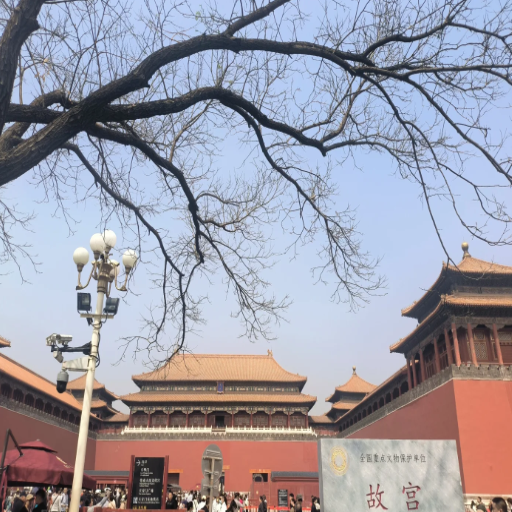
When is the Best Time to Visit Beijing for a 4-day Trip
From personal experience, the perfect period for a 4-day trip to Beijing would be spring (March to May) or autumn (September to October). During these months, the weather is moderate, the likelihood of rain is low, and outdoor venturing would be exceedingly rewarding. Moreover, the city is full of blooming flowers in spring and beautiful places in fall, such as Beihai Park or the Summer Palace. The summer months are peak tourist season, allowing for a more leisurely visit to the more frequented sites.
Understanding Beijing’s Seasons and Climate
Distinctly different seasonal characteristics affect travel plans to Beijing. Summers (June-August) are generally hot and humid, with average temperatures reaching between 25°C and 35°C (77F to 95F) along with rainfall; October is particularly wet with frequent rains. Winters (December-February) are significantly colder and dryer, with temperatures sinking to 14F (-10C) and powerful winds. During spring (March-May), moderate temperatures around 10C to 25C (50 to 77F) are present, accompanied by dust storms due to dryness. Autumn (Sep-Oct) is the best season as it boasts comfortable daytime temperatures of 15C to 25C (59F to 77F) with clear skies and beautiful leaves. By understanding these patterns, one can enhance the experience of Beijings attractions as there is something to do throughout the year.
Choosing the Optimal Time to Visit the Great Wall
The Great Wall can be visited at any time of the year, but the best time would be September and October. During this period, the temperature is comfortable, with the average temperature being around 59°F to 77°F (15°C to 25°C). This makes it ideal for hiking, and the clear skies add to the experience by offering unobstructed views of the area. Another great option would be in the spring, from March to May, when temperatures are similar, and the atmosphere feels fresh, but you should remember that dust storms are possible. Summer should be entirely skipped due to sweltering temperatures paired with a surge in tourists, and winter should also be avoided due to the extreme cold weather, which makes the paths icy and walking difficult. The rest of the Great Wall can be enjoyed without many tourists on early mornings and weekdays, which would make for better experiences.
References
Frequently Asked Questions (FAQ)
Q: What is the best itinerary for 4 days in Beijing to explore the Great Wall?
A: A four-day itinerary for Beijing could include visiting the Mutianyu Great Wall, exploring the Forbidden City, taking a walking tour of the traditional Hutong, and enjoying a city tour. To maximize your experience, you can dedicate each day to different attractions in Beijing.
Q: How can I visit the Great Wall of China during my Beijing trip?
A: During your Beijing trip, you can visit sections like the Badaling Great Wall or Mutianyu Great Wall. Both are accessible by train or private tour from Beijing city. These sections offer stunning views and well-preserved paths.
Q: What are some must-see attractions in Beijing during a 4-day visit?
A: Must-see attractions in Beijing include the Forbidden City, Temple of Heaven, Summer Palace, and visiting Beijing’s traditional Hutong. You should also consider a city tour to get a comprehensive view of the capital of China.
Q: How do I get from Shanghai to Beijing for my 4-day Beijing itinerary?
A: You can take a high-speed train or a flight from Shanghai to Beijing. The train to Beijing provides a comfortable and scenic journey, while flights offer a faster alternative.
Q: What is the best way to travel around Beijing during my stay?
A: The subway, buses, and taxis are efficient ways to travel around Beijing. For a more guided experience, consider a group or private tour.
Q: Where should I stay in Beijing to easily access major attractions?
A: Staying in central areas like Wangfujing or near the Beijing Capital International Airport offers convenient access to major attractions and public transport. These locations make it easier to visit places in Beijing.
Q: What are the best times to visit Beijing for a 4-day itinerary?
A: The best times to visit Beijing are spring (April to June) and autumn (September to November) when the weather is pleasant for exploring. This timing enhances the experience of your Beijing travel itinerary.
Q: Should I include any cultural experiences in my Beijing travel itinerary?
A: For a comprehensive cultural experience during your trip to Beijing, consider taking a walking tour of a traditional Hutong, attending a Peking opera performance, and trying local cuisine.
Q: How can I ensure a smooth arrival and departure at Beijing airports?
A: Plan your arrival and departure through Beijing Capital International Airport or Beijing Daxing International Airport. Ensure you have all travel documents ready, and consider arranging airport transfers in advance for a smooth experience.
Q: What can I do if I have extra time after my planned 4 days in Beijing?
A: If you have extra time, consider a short trip to nearby places like the Ming Tombs or a day trip back to Beijing’s surrounding areas for more attractions in Beijing.